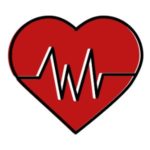
Healthy Heart for a Healthy Life!
February is widely recognized as Heart Month, and in honor of that we are offering up some heart healthy goodness for ya! Read all the way through for a treat for yourself as well <3
This post features an excerpt from our CEC Course, Healthy Heart for a Healthy Life. Trainers work with people from all walks of life, and trainees returning to an exercise program after medical procedures or diagnoses will likely be part of your training experience. Rehabilitation following a cardiac event is a multi-step process, and this piece gives an overview of the progression.
Cardiac Rehabilitation and Return to Unsupervised Exercise
Cardiac Rehabilitation is a medically based, professionally supervised program that assists people in recovering from heart attacks, heart surgeries, and other coronary interventions such as PTCA (angioplasty) and stenting.
Cardiac rehab intervention, most often prescribed by doctor referral, has been shown to reduce rates of re-hospitalization, lower mortality rate, decrease the need for cardiac medications, and increase the rate at which people return to work.
In cardiac rehabilitation, clients are carefully monitored and under the supervision of a cardiac registered nurse and other medical professionals. There is a crash cart present in the facility for if an emergency arises. Clients are taught to self monitor and connect with their body through Rate of Perceived Exertion (RPE) and other means in order to listen to their body, monitor symptoms, and to exercise safely and appropriately.
Special medical training and equipment is required in cardiac rehabilitation. Although clients may want to skip a long drive to go into town to go to cardiac rehab, or it may not be at convenient times, it is important that cardiac rehab be completed and they are cleared to join/participate in a community setting. It is very unwise to allow clients to participate in community programs without proper participation and clearance from cardiac rehabilitation. Physician’s consent for participation in a group fitness certification class, personal training, or small group training is strongly advised and initial (preferably ongoing) communication with the cardiac rehab team is encouraged.
Phases of Cardiac Rehabilitation | |
Phase | Description |
Phase I (Inpatient) |
|
Phase II (Outpatient) |
|
Phase III |
|
Phase IV |
|
Working with clients that have heart disease in a group or individual setting requires fitness professionals to follow safe guidelines and recommendations. It is important to understand these exercise guidelines especially for those who have heart disease and have attended cardiac rehabilitation phase 2. Educate yourself, seek advice, and consider shadowing an experienced professional when creating a client base for those who have been cleared to exercise in cardiac rehabilitation phase 3 and 4 programs.
The information in this course is from the NAFC Continuing education course “Healthy Heart for a Healthy Life” by Tina Schmidt-McNulty.
Alright, now for your treat! We are offering a discount on this course all February. When you purchase it, use discount code HEART2020 for 25% off the list price. This course is worth .3 CECs toward your certification renewal!






No comment yet, add your voice below!